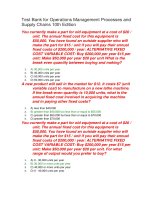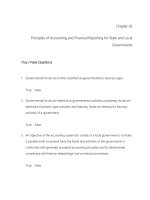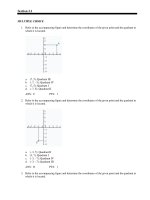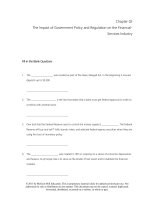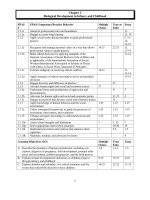Mathematical applications for the management life and social sciences 10th edition harshbarger test bank
Bạn đang xem bản rút gọn của tài liệu. Xem và tải ngay bản đầy đủ của tài liệu tại đây (861.45 KB, 68 trang )
Harshbarger/Reynolds, Mathematical Applications for the Management, Life, and Social Sciences, 10e
Chapter 2 Quadratic and Other Special Functions
1. Write the equation x 2 4 x 7 5 5 x 2 in general form.
A)
6 x 2 4 x 12 0
B)
x2 4x 2 0
C)
6 x2 4 x 2 0
D)
x 2 4 x 12 0
E)
6 x 2 4 x 2 0
Ans: C
2. Write the equation z 2 z 8 3 in general form.
A)
z 2 10 z 13 0
B)
z 2 10 z 16 0
C)
z 2 8 z 13 0
D)
z 2 8 z 16 0
E)
z 2 8 z 16 0
Ans: A
3. Solve the equation x 2 – 5 x x 16 .
A)
x –8, x 2
B)
x 8, x 2
C)
x –8, x –2
D)
x 16, x –4
E)
x 8, x –2
Ans: E
4. Solve the equation 4 x 2 4 x 1 0 by factoring.
A)
1
x
2
B)
1
x
2
C)
x2
D)
1
x
4
E)
1
1
x ,x
2
2
Ans: B
©2013 Cengage Learning. All Rights Reserved.
Page 207
Harshbarger/Reynolds, Mathematical Applications for the Management, Life, and Social Sciences, 10e
5. Solve the equation by using the quadratic formula. Give real solutions only.
3x 2 x 1 0
A)
1 –11
x
6
B)
1 –11
x
6
C)
1 13
x
6
D) no real solutions
E)
1 –11
x
3
Ans: D
6. Solve the equation by using the quadratic formula. Give real answers rounded to two
decimal places.
6x2 4x 7
A)
x 1.46, x –0.80
B)
x 1.46, x –0.80
C)
x 15.67, x 13.00
D)
x 2.33, x 0.20
E)
x 1.71, x –0.55
Ans: A
7. Find the exact real solutions to the equation, if they exist.
y2 7
A)
y 7
B)
y 7
C)
D)
y 3.5
y 7
E) no real solutions
Ans: D
8. Find the exact real solutions to the equation, if they exist.
( x 7)2 64
x 1, x –15
A)
B)
x 8
C)
x 57
D)
x 71
E)
x 8
Ans: A
©2013 Cengage Learning. All Rights Reserved.
Page 208
Harshbarger/Reynolds, Mathematical Applications for the Management, Life, and Social Sciences, 10e
9. Find the exact real solutions of the equation x 2 16 x 4 x 35 , if they exist.
A)
x 5 and x 7
B)
x 5 and x 7
C)
x 6 and x 8
D)
x 6 and x 7
E)
x 6 and x 8
Ans: B
10.
5 y 2 17
y 1 0 , if they exist.
Find the exact real solutions of the equation
24 12
A)
4
y and y 6
5
B)
y 4 and y 6
C)
y 4 and y 6
D)
4
y and y 6
5
E)
y –6 and y 4
Ans: D
11. Find the exact real solutions of the equation 6 x 2 12 x 5 , if they exist.
A)
66
66
x 1
and x 1
6
6
B)
6
6
x 1
and x 1
6
6
C)
31
31
x 1
and x 1
6
6
D)
6
6
x 1
and x 1
5
5
E) Real solutions do not exist.
Ans: B
12. Solve the equation by using a graphing utility.
–14 x 105 7 x 2 0
A)
x 3, x –5
B)
x 3, x 3
x –42, x 70
C)
D)
x –3, x 5
x –7, x 105
E)
Ans: A
©2013 Cengage Learning. All Rights Reserved.
Page 209
Harshbarger/Reynolds, Mathematical Applications for the Management, Life, and Social Sciences, 10e
13. Solve the equation 6.5 z 2 6.3z 2.6 0 by using a graphing utility. Round your
answer to two decimal places.
A)
x 1.04 or x –0.07
B)
x 1.86 or x –0.92
C)
x 1.28 or x –0.31
D)
x 1.75 or x –0.78
E)
x 1.40 or x –0.43
Ans: C
14.
Multiply both sides of the equation x
9
10 by the LCD, and then solve the resulting
x
quadratic equation.
A)
x 9,1
B)
x 10,1
C)
x 9,10
D)
x 1, 1
E)
x 9, 1
Ans: A
15.
x
4
by first multiplying by the LCD, and then solving
5x
x4
x4
the resulting equation.
A)
x 1
B)
x 1
C)
1
x
5
D)
1
x ,x 4
5
E)
1
x
5
Ans: D
Solve the equation
16. Solve the equation below using quadratic methods.
( x 8)2 3( x 8) 2 0
A)
x 10, x 9
B)
x 8, x 2
x 6, x 1
C)
x –10, x –9
D)
E)
x 8, x 3
Ans: D
©2013 Cengage Learning. All Rights Reserved.
Page 210
Harshbarger/Reynolds, Mathematical Applications for the Management, Life, and Social Sciences, 10e
17. If the profit from the sale of x units of a product is p 85 x 400 x 2 , what level(s) of
production will yield a profit of $ 1100 ?
A) less than 25 units of production.
B) more than 60 units of production
C)
85 units of production
D)
35 units of production
E)
25 or 60 units of production.
Ans: E
18. If a ball is thrown upward at 64 feet per second from the top of a building that is 100
feet high, the height of the ball can be modeled by
s 100 64t 16t 2 , where t is the number of seconds after the ball is thrown. How long
after it is thrown is the height 100 feet?
A)
t 4 seconds
B)
t 32 seconds
C)
t 1 seconds
D)
t 64 seconds
E)
t 5.20 seconds
Ans: A
19. The amount of airborne particulate pollution p from a power plant depends on the wind
speed s, among other things, with the relationship between p and s approximated by
p 49 0.01s 2 . Find the value of s that will make p 0 .
A)
s 700
B)
s 80
C)
s 70
D)
s 49
E)
s 490
Ans: C
20. The sensitivity S to a drug is related to the dosage size by S 90 x x 2 , where x is the
dosage size in milliliters. Determine all dosages that yield 0 sensitivity.
A)
x 0 milliliters, x 9 milliliters
B)
x 0 milliliters, x 90 milliliters
C)
x 0 milliliters, x 90 milliliters
D)
x 90 milliliters, x 90 milliliters
E)
x 0 milliliters
Ans: B
©2013 Cengage Learning. All Rights Reserved.
Page 211
Harshbarger/Reynolds, Mathematical Applications for the Management, Life, and Social Sciences, 10e
21. The time t, in seconds, that it takes a 2005 Corvette to accelerate to x mph can be
described by t 0.001 0.729 x 2 15.415 x 607.738 . How fast is the Corvette going
after 9.06 seconds? Give your answer to the nearest tenth.
A) 101.6 mph
B) 97.6 mph
C) 103.6 mph
D) 118.3 mph
E) 118.8 mph
Ans: B
22. Suppose that the percent of total personal income that is used to pay personal taxes is
given by y 0.034 x 2 0.044 x 12.642 , where x is the number of years past 1990
(Source: Bureau of Economic Analysis, U.S. Department of Commerce). Find the year
or years when the percent of total personal income used to pay personal taxes is 14
percent.
A)
2007
B) 1997
C) 1996
D)
2032
E)
2004
Ans: B
23. A fissure in the earth appeared after an earthquake. To measure its vertical depth, a
stone was dropped into it, and the sound of the stone's impact was heard 3.1 seconds
later. The distance (in feet) the stone fell is given by s 18t12 , and the distance (in feet)
the sound traveled is given by s 1090t2 . In these equations, the distances traveled by
the sound and the stone are the same, but their times are not. Using the fact that the total
time is 3.1 seconds, find the depth of the fissure. Round your answer to two decimal
places.
A) 63.51 feet
B) 60.56 feet
C) 157.25 feet
D) 161.25 feet
E) 162.25 feet
Ans: C
24. An equation that models the number of users of the Internet is
y 11.786 x 2 142.214 x 493 million users, where x is the number of years past 1990
(Source: CyberAtlas, 1999). If the pattern indicated by the model remains valid, when
does this model predict there will be 500 million users?
A)
2001
B)
2014
C)
2011
D)
2005
E)
2003
Ans: E
©2013 Cengage Learning. All Rights Reserved.
Page 212
Harshbarger/Reynolds, Mathematical Applications for the Management, Life, and Social Sciences, 10e
25. The model for body-heat loss depends on the coefficient of convection K, which
depends on wind speed v according to the equation K 2 19v 5 where v is in miles per
hour. Find the positive coefficient of convection when the wind speed is 26 mph. Round
your answer to the nearest integer.
A)
K 19
B)
K 22
C)
K 5
D)
K 8
E)
K 20
Ans: B
26. Find the vertex of the graph of the equation
y 0.125 x 2 x
A)
(4, –2)
B)
(4, 2)
C)
(–2, –4)
D)
(–4, –2)
E)
(0,8)
Ans: D
27. Determine if the vertex of the graph of the equation is a maximum or minumim point.
1
y x 2 3x
4
A) vertex is at a maximum point
B) vertex is at a minimum point
C) has no vertex
Ans: B
28. Find the vertex of the graph of the equation
y 2 x 2 – 3x
A)
(0.75, –1.13)
B)
(2, –3)
C)
(0,1.50)
D)
(–1.13, 0.75)
E)
(1.50, 1.50)
Ans: A
©2013 Cengage Learning. All Rights Reserved.
Page 213
Harshbarger/Reynolds, Mathematical Applications for the Management, Life, and Social Sciences, 10e
29. Determine what value of x gives the optimal value of the function, and determine the
optimal (maximum or minimum) value.
y 2 x 2 – 3x
A) optimal value of x: 0, optimal value: 1
B) optimal value of x: –1.13 , optimal value: 0.75
C) optimal value of x: 1.50 , optimal value: –1.50
D) optimal value of x: –0.75 , optimal value: –1.13
E) optimal value of x: 0.75 , optimal value: –1.13
Ans: E
30. Determine whether the function’s vertex is a maximum point or a minimum point and
find the coordinates of this point.
y x 2 12 x 6
A) vertex: (–6, –30) , a minimum point
B) vertex: (6, –42) , a maximum point
C) vertex: (6, –42) , a minimum point
D) vertex: (–6, –30) , a maximum point
E) vertex: (–42, 6) , a maximum point
Ans: A
©2013 Cengage Learning. All Rights Reserved.
Page 214
Harshbarger/Reynolds, Mathematical Applications for the Management, Life, and Social Sciences, 10e
31. Sketch the graph of the following function.
A)
B)
C)
D)
©2013 Cengage Learning. All Rights Reserved.
Page 215
Harshbarger/Reynolds, Mathematical Applications for the Management, Life, and Social Sciences, 10e
E)
Ans: B
32. Find the zeros, if any exist.
y x 2 9 x 15
A) zeros at –2.21 and –6.79
B) zeros at 0 and 9
C) zeros at 6.00 and –15.00
D) no zeros
E) zeros at x 0 and 21
Ans: A
©2013 Cengage Learning. All Rights Reserved.
Page 216
Harshbarger/Reynolds, Mathematical Applications for the Management, Life, and Social Sciences, 10e
33. Determine whether the vertex of the graph of the following function vertex is a
maximum point or a minimum point. Also find the coordinates of the vertex.
1 2
x + 2x y – 8 0
7
A) vertex: (–7, –15) , a maximum point
B) vertex: (–7, –15) , a minimum point
C) vertex: (7, –15) , a minimum point
D) vertex: (14, 48) , a minimum point
E) vertex: (–15, 7) , a maximum point
Ans: B
34. Find the x-intercepts, if any exist.
1 2
x + 3x y – 5 0
4
A) x-intercepts: x –6.00, x –14.00
B) x-intercepts: x –1.48, x 13.48
C) x-intercepts: x 1.48, x –13.48
D) x-intercepts: x 12.00, x 67.00
E) no x-intercepts
Ans: C
35. How is the graph of y x 2 shifted to obtain the graph of the function y ( x 5)2 11 ?
A) shifted 5 units to the left and 11 units up
B) shifted 5 units to the right and 11 units down
C) shifted 25 units to the left and 11 units up
D) shifted 10 units to the right and 11 units down
E) shifted 5 units to the right and 11 units up
Ans: E
36. Use a graphing utility to find the vertex of the function.
1 2
3
y
x x
20
4
A) vertex: (10, –5.75)
B) vertex: origin
C) vertex: (10,15.75)
D) vertex: (10,14.25)
E) vertex: (10, –5.75)
Ans: A
©2013 Cengage Learning. All Rights Reserved.
Page 217
Harshbarger/Reynolds, Mathematical Applications for the Management, Life, and Social Sciences, 10e
37. Sketch the graph of the following function by using graphing calculator.
A)
B)
C)
D)
©2013 Cengage Learning. All Rights Reserved.
Page 218
Harshbarger/Reynolds, Mathematical Applications for the Management, Life, and Social Sciences, 10e
E)
Ans: D
38. Find the average rate of change of the function between the given values of x.
y 5 x x 2 between x –8 and x 3 .
A) 11
B)
24
C)
0
D)
–6
E)
48
Ans: C
39. Find the vertex and then determine the range of the function.
y 71 0.2 x – 0.01x 2
A) all values greater than or equal to 72
B) all values less than or equal to 68
C) all values greater than or equal to 10
D) all values less than or equal to 90
E) all values less than or equal to 72
Ans: E
©2013 Cengage Learning. All Rights Reserved.
Page 219
Harshbarger/Reynolds, Mathematical Applications for the Management, Life, and Social Sciences, 10e
40. Use a graphing utility to approximate the solutions to f ( x) 0 .
f ( x) 3x 2 – 20 x 20
A)
x 16.32, x 3.68
B)
x –1.23, x –5.44
C)
x 5.44, x 1.23
D)
x 3.33, x –13.33
E)
x 5.44, x 1.23
Ans: C
41. Factor the function f ( x) 2 x 2 – 21x 49 .
A)
f ( x) ( x 7)( x 7)
B)
f ( x) –21( x 7)(2 x 7)
C)
f ( x) ( x 7)(2 x 7)
D)
7
f ( x) ( x 7)( x )
2
E)
f ( x) (7 x 1)(2 x 7)
Ans: C
42. Solve f ( x) 0 for the function f ( x) 5 x 2 –102 x 289 .
A)
17
x , x –102
5
B)
17
x 17, x
5
C)
5
x 17, x
17
D)
17
x 17, x
5
E) no real solutions
Ans: D
43. The daily profit from the sale of a product is given by P 20 x – 0.2 x 2 – 99 dollars.
What level of production maximizes profit?
A) production level of 100 units
B) production level of 10 units
C) production level of 5 units
D) production level of 50 units
E) production level of 95 units
Ans: D
©2013 Cengage Learning. All Rights Reserved.
Page 220
Harshbarger/Reynolds, Mathematical Applications for the Management, Life, and Social Sciences, 10e
44. The daily profit from the sale of a product is given by P 20 x – 0.2 x 2 – 96 dollars.
What is the maximum possible profit?
A) $ 894
B) $ 1404
C) $ 404
D) $ 50
E) $ 95
Ans: C
45. The daily profit from the sale of a product is given by P 88 x – 0.3x 2 – 210 dollars.
What is the maximum possible profit? Round your answer to the nearest dollar.
A) $ 6, 243
B) $ 19, 209
C) $ 12, 682
D) $ 147
E) $ 291
Ans: A
46. The yield in bushels from a grove of orange trees is given by Y x 1100 x , where x
is the number of orange trees per acre. How many trees will maximize the yield?
A) 1100 trees
B) 2200 trees
C) 600 trees
D) 1150 trees
E) 550 trees
Ans: E
47. The sensitivity S to a drug is related to the dosage x in milligrams by S 980 x x 2 .
Use a graphing utility to determine what dosage gives maximum sensitivity.
A)
98
B)
240,100
C)
980 and x 0
D)
980
E)
490
Ans: E
48. A ball thrown vertically into the air has its height above ground given by
s 112t –16t 2 , where t is in seconds and s is in feet. Find the maximum height of the
ball.
224 feet
A)
B) 112 feet
C)
7 feet
D) 16 feet
E)
196 feet
Ans: E
©2013 Cengage Learning. All Rights Reserved.
Page 221
Harshbarger/Reynolds, Mathematical Applications for the Management, Life, and Social Sciences, 10e
49. The owner of a skating rink rents the rink for parties at $ 648 if 54 or fewer skaters
attend, so that the cost per person is $ 12 if 54 attend. For each 5 skaters above 54 ,
she reduces the price per skater by $0.50. Which table gives the revenue generated if
54 , 64 , and 74 skaters attend?
A)
Price No. of skaters Total Revenue
B)
54
$ 740
12
64
$ 704
11
74
10
$ 648
Price No. of skaters Total Revenue
C)
54
$ 648
12
64
13
$ 704
74
$ 740
14
Price No. of skaters Total Revenue
D)
54
$ 648
12
64
$ 704
11
74
10
$ 740
Price No. of skaters Total Revenue
E)
54
$ 648
12
64
13
$ 832
74
$ 1036
14
Price No. of skaters Total Revenue
12
11.5
11
54
64
74
$ 648
$ 736
$ 814
Ans: C
50. When a stone is thrown upward, it follows a parabolic path given by a form of the
equation y ax 2 bx c. If y 0 represents ground level, find the equation of a stone
that is thrown from ground level at x 0 and lands on the ground 100 units away if the
stone reaches a maximum height of 100 units.
A)
1
y x2 2x
50
B)
1
y x2 4x
25
C)
1
y 4x2 x
25
D)
1
y 2 x 2 x
50
2
E)
y 2 x 50 x
Ans: B
©2013 Cengage Learning. All Rights Reserved.
Page 222
Harshbarger/Reynolds, Mathematical Applications for the Management, Life, and Social Sciences, 10e
51. In 1995, America’s 45 million Social Security recipients received a 2.6% cost-of-living
increase, the second smallest increase in nearly 20 years, a reflection of lower inflation.
The percent increase might be described by the function
p(t ) –0.4375t 2 7.4t – 34.3625 , where t is the number of years past 1980. In what
year does the model predict the highest cost of living percent increase?
A) 1989
B)
2008
C) 1986
D) 1988
E) none of the above
Ans: D
©2013 Cengage Learning. All Rights Reserved.
Page 223
Harshbarger/Reynolds, Mathematical Applications for the Management, Life, and Social Sciences, 10e
52. Sketch the first quadrant portions of the following functions and estimate the market
equilibrium point.
1
Supply : p q 2 10
2
Demand : p 84 26q 5q 2
A)
E : 4,18
B)
E : 2,12
C)
©2013 Cengage Learning. All Rights Reserved.
Page 224
Harshbarger/Reynolds, Mathematical Applications for the Management, Life, and Social Sciences, 10e
E : 4,14
D)
E : 4,14
E)
E : 2,12
Ans: B
©2013 Cengage Learning. All Rights Reserved.
Page 225
Harshbarger/Reynolds, Mathematical Applications for the Management, Life, and Social Sciences, 10e
53.
1 2
q 40 , and the demand function is
2
decribed by the equation p 86 6q 3q 2 . Algebraically determine the equilibrium
point for the supply and demand functions.
A)
E (2.87, –4.58)
B)
E (–4.58, 44.11)
C)
1
E ( ,86)
2
D)
E (2.87, 44.11)
E)
E (2.87, 4.11)
Ans: D
A supply function has the equation is p
p q 2 8q 16 and the demand function is
p –9q 2 6q 426 , find the equilibrium quantity and equilibrium price.
A)
E (6.30,35.15)
B)
E (–6.50, 72.74)
C)
E (6.30, 72.74)
D)
E (6.30,51.15)
E)
E (6.30,106.17)
Ans: E
54. If the supply function for a commodity is
55. If the supply and demand functions for a commodity are given by 8 p q 290 and
p 2 q 5720, respectively, find the price that will result in market equilibrium.
A) 38
B) 110
C) 50
D) 142
E) 63
Ans: C
56. If the supply and demand functions for a commodity are given by p q 10 and
q (2 p 10) 1000 , what is the equilibrium price and what is the corresponding number
of units supplied and demanded?
A)
E (30.00, 20.00)
B)
E (30.00, –15.00)
C)
E (30.00, 40.00)
E (15.00, –25.00)
D)
E)
E (15.00, 40.00)
Ans: A
©2013 Cengage Learning. All Rights Reserved.
Page 226
Harshbarger/Reynolds, Mathematical Applications for the Management, Life, and Social Sciences, 10e
57. The supply function for a product is 2 p q 10 0, while the demand function for the
same product is ( p 10)(q 30) 7200 . Find the market equilibrium point E(q,p).
A)
E (110.00,50.00)
B)
E (–150.00, –70.00)
C)
E (30,10)
D)
E (90.00,50.00)
E)
E (–70.00,50.00)
Ans: D
58. The supply function for a product is 2 p q 10 0, while the demand function for the
same product is ( p 10)(q 30) 6600 . If a $22 tax is placed on production of the
item, then the supplier passes this tax on by adding $22 to his selling price. Find the new
equilibrium point E(q,p) for this product when the tax is passed on. (The new supply
function is given by p 12 q 27.)
A)
E (32.17, 43.08)
B)
E (44.46, 49.23)
C)
E (32.17, 49.23)
D)
E (64.98,59.49)
E)
E (–168.98, 43.08)
Ans: D
59. The total costs for a company are given by C ( x) 2,925 20 x x 2 , and the total
revenues are given by R( x) 130 x . Find the break-even points.
A) Break-even values are at x 45 and x 65 units.
B) Break-even values are at x inf units.
C) Break-even values are at x inf units.
D) Break-even values are at x 22.50 and x 32.50 units.
E) Break-even values are at x 65 units.
Ans: A
60. If a firm has the following cost and revenue functions, find the break-even points.
1
C ( x) 4800 25 x x 2 ,
2
1
R( x) 215 x x
2
A) Break-even values are at x 40 and x 160 units.
B) Break-even values are at x 30 and x 110 units.
C) Break-even values are at x 40 and x 110 units.
D) Break-even values are at x 160 and x 110 units.
E) Break-even values are at x 30 and x 160 units.
Ans: E
©2013 Cengage Learning. All Rights Reserved.
Page 227
Harshbarger/Reynolds, Mathematical Applications for the Management, Life, and Social Sciences, 10e
61. If a company has total costs C ( x) 15,000 35 x 0.1x 2 , and total revenues given by
R( x) 385 x 0.9 x 2 , find the break-even points.
A) Break-even values are at x 300 and 175 units.
B) Break-even values are at x 300 and 50 units.
C) Break-even values are at x 0 and 427.78 units.
D) Break-even values are at x 175 units.
E) Break-even values are at x 175 and 427.78 units.
Ans: B
62. If total costs are C ( x) 1100 1500 x and total revenues are R( x) 1620 x x 2 , find
the break-even points.
A) Break-even values are at x 10 and x 50 units.
B) Break-even values are at x 10 and x 110 units.
C) Break-even values are at x 50 and x 110 units.
D) Break-even values are at x 10 and x 115 units.
E) Break-even values are at x 50 and x 115 units.
Ans: B
63. Given the profit function, P( x) –14.5 x 0.1x 2 300 , and that production is restricted
to fewer than 75 units, find the break-even point(s).
A) Break-even value is at x 21 units.
B) Break-even value is at x 20.83 units.
C) Break-even value is at x 75 units.
D) Break-even value is at x 120 units.
E) Break-even value is at x 25 units.
Ans: E
64. Find the maximum revenue for the revenue function R( x) 475 x 0.8 x 2 .
A) $70,507.81
B) $211,523.44
C) $52,880.86
D) $193,896.48
E) $212,523.44
Ans: A
65. If, in a monopoly market, the demand for a product is p 170 – 0.25 x , and the revenue
function is R px , where x is the number of units sold, what price will maximize
revenue?
A) Price that will maximize revenue is p $85.00 .
B) Price that will maximize revenue is p $191.25 .
C) Price that will maximize revenue is p $255.00 .
D) Price that will maximize revenue is p $340.00 .
E) Price that will maximize revenue is p $170.00 .
Ans: A
©2013 Cengage Learning. All Rights Reserved.
Page 228
Harshbarger/Reynolds, Mathematical Applications for the Management, Life, and Social Sciences, 10e
66. The profit function for a certain commodity is P( x) 110 x x 2 900 . Find the level of
production that yields maximum profit, and find the maximum profit.
A) Production levels of 110 yields a maximum profit of $ 900 .
B) Production levels of 110 yields a maximum profit of $ 2125 .
C) Production levels of 55 yields a maximum profit of $ 5095 .
D) Production levels of 55 yields a maximum profit of $ 3025 .
E) Production levels of 55 yields a maximum profit of $ 2125 .
Ans: E
©2013 Cengage Learning. All Rights Reserved.
Page 229
Harshbarger/Reynolds, Mathematical Applications for the Management, Life, and Social Sciences, 10e
67. Use a graphing calculator to graph the profit function P( x) 70 x 0.1x 2 6000.
A)
B)
C)
D)
©2013 Cengage Learning. All Rights Reserved.
Page 230
Harshbarger/Reynolds, Mathematical Applications for the Management, Life, and Social Sciences, 10e
E)
Ans: E
©2013 Cengage Learning. All Rights Reserved.
Page 231
